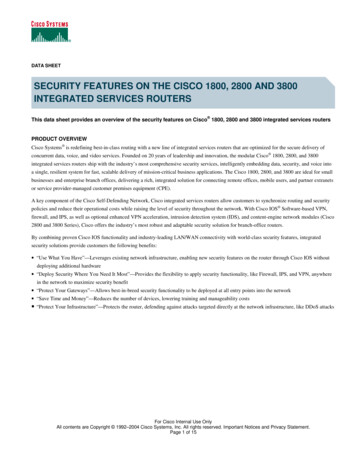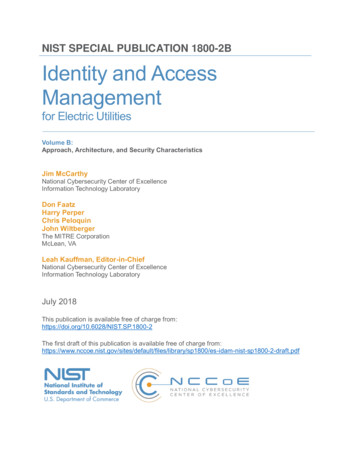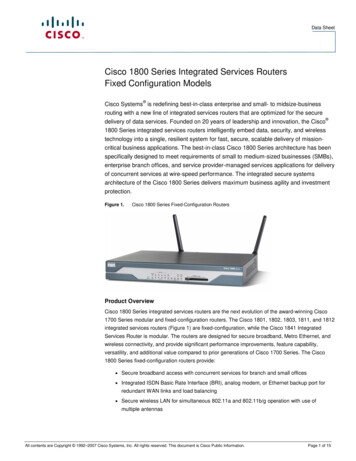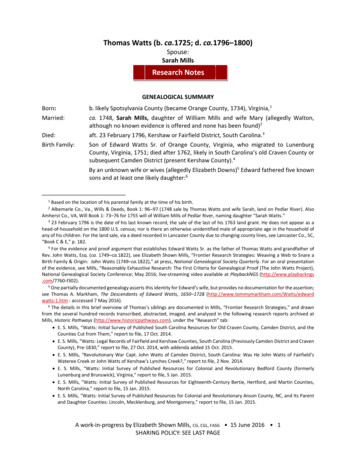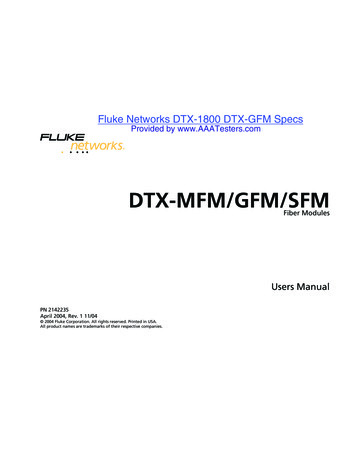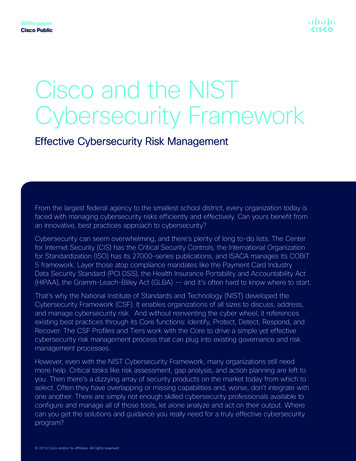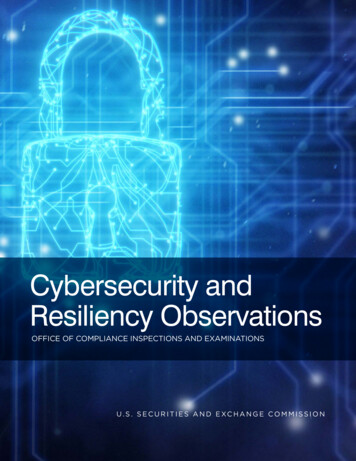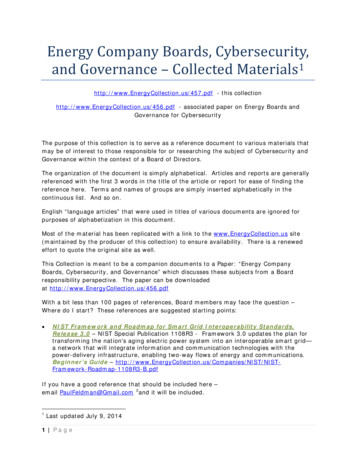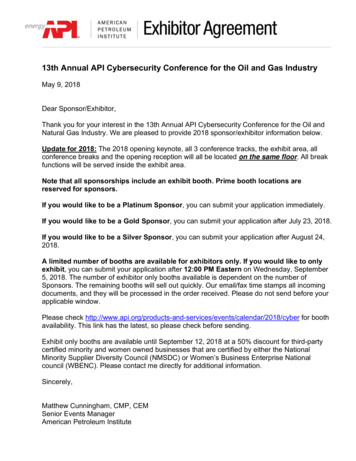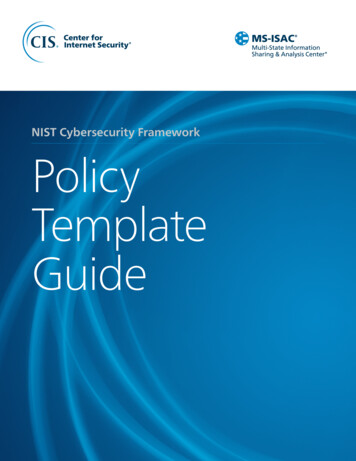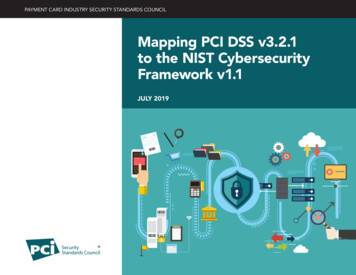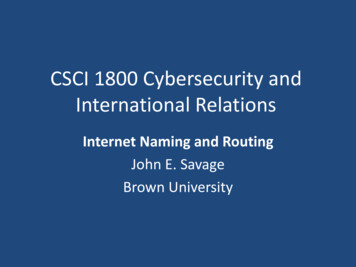
Transcription
CSCI 1800 Cybersecurity andInternational RelationsInternet Naming and RoutingJohn E. SavageBrown University
Outline The Domain Name System (DNS)– Protecting the DNS from attacks History of Naming Policy Internet routing– The Border Gateway Protocol (BGP)– Protecting BGP from attacks Routing PolicyLect06 2/12/2020 JE Savage2
The Domain Name System
The Domain Name System (DNS) DNS is the “telephone directory” for the Internet. DNS is a distributed, hierarchical, naming system. DNS translates host names into IP addresses.– www.example.com translates to the addresses192.0.32.10 (IPv4) and 2620:0:2d0:200::10 (IPv6). Names are hierarchical– .com is a top-level domain– example.com is a second-level domain of .com– aaa.example.com is sub-domain of example.comLect06 2/12/2020 JE Savage4
Domain Names Four types of top-level domain (TLD):– Country codes (2 letters, e.g. .ca, .au, .de, .hu, .uk)– Sponsored codes (e.g. .coop, .jobs, .post, .gov, .mil, .int)– Historical top level (e.g. .com, .net, .edu, .org,) 1,540 active TLDs, e.g. .IBM, .NYC, .REISE, COOKINGCHANNEL Domain names are registered and assigned bydomain-name registrars† who are accredited by theInternet Corporation for Assigned Names andNumbers (ICANN).† See list.htmlLect06 2/12/2020 JE Savage5
Organization of the DNS The DNS resolves names into IP addresses. Root name servers hold IP addresses for toplevel name servers, e.g. .edu, .uk. and .net. Top-level name servers hold IP addresses forsub-domain name servers, e.g. example.com.Root servercomhpLect06 2/12/2020edugapcmu JE SavageTop-level servermit2nd-level server6
Querying the DNS Local caches hold records mapping domain names toIP addresses. If the time to live (TTL) for a domainexpires, another lookup is done. TTL about 2 hours When local cache is queried for a name that is not inthe cache, it is fetched via root server and cache isupdated with new mapping. Root server is asked for IP address of name serverfor top-level domain, which is asked for IP address ofsecond-level domain server, etc., until authoritativeserver is reached, which returns correct IP address.Lect06 2/12/2020 JE Savage7
DNS Cache Poisoning Eve tricks DNS cache into mapping a domain name to fakeIP addr– Users will go to fake IP address until TTL reached Steps Eve takes to poison the cache:1. Eve sends a request IP address for DNS name not in cache2. Cache asks authoritative server S for mapping, sending to ita 16-bit ID. The server responds with same ID after delay3. Eve guesses 16-bit ID but responds to cache before S doeswith incorrect answer.4. If Eve guesses ID correctly, DNS accepts her answer andignores later input from authoritative server S.5. Cache is poisoned with fake IP address for the domain name.Lect06 2/12/2020 JE Savage8
Protecting DNS Caches Problems in protecting DNS caches:– 16-bit IDs on DNS queries are short, too easily guessed– It only takes 64K* tries to find correct ID How to harden DNS caches:– Only allow updates from within local network. If update is from outside local network, don’t trust it.– Provide port number when querying root zone andrequire that responses have correct port no. and ID.– Number of choices goes from 216 to 232!* K 210 1,024Lect06 2/12/2020 JE Savage9
Public Key Cryptography Alice and Bob have public and privatekeys PrvA, PubA and PrvB, PubB Bob encrypts a message for Alice usingher public key PubA. She decrypts itusing her private key PrA. Alice sends messages to Bob thesame way. Using this method, they cancommunicate in secret.Lect06 2/12/2020 JE SavagePubAPrvA10
Cryptographic Signing of MessagesHash function mapsdata of arbitrarysize to fixed size. Isdifficult to invert.Signer’s publickey is attachedLect06 2/12/2020 JE Savage11
DNSSEC: Security Extensions to DNS DNS is not secure! DNSSEC provides trust Under DNSSEC, DNS replies are cryptographicallysigned using public key encryption.– A message identifying sender is encrypted by sender.– Public decryption key is used to verify author. Source has authority granted by issuer of keys Chain of trust here. Ultimately, must trust root. Most TLDs are protected by DNSSECLect06 2/12/2020 JE Savage12
History of Naming Policy
Names Matter Domain names can be expensive,– insurance.com cost 35.6 million in 2010– cars.com cost 872 M in 2014– Suffixes such as .xxx , .sucks may be controversial. Who should have the authority to decide onownership and assignment of domain namesand IP addresses?Lect06 2/12/2020 JE Savage14
Early Days In early 1970s naming system consisted of smallfile called “hosts.txt” placed at each host. In 1978 Jon Postel of USC was given no-bid USGcontract to run Internet naming & numbering By mid 1980s Postel and SRI had created themodern domain name system. By 1990s DoD required contract bidding.Lect06 2/12/2020 JE Savage15
Commercialization of Internet In May 1990 Government Systems, Inc. winscontract to administer the root (Postel’s job)which it hands over to Network Solutions. In 1995 Network Solutions wins right tocharge for registering domain names. Domain names become very popular andNetwork Solutions earns fabulous profits. Engineers disenchanted.Lect06 2/12/2020 JE Savage16
First Attempt at Capturing the Root In June 1991 Vint Cerf and others announceformation of Internet Society (ISOC).– Goal: Provide Internet governing structure, home, andfunding that is independent of USG– Milt Mueller: An attempt to self-privatize the Internet. In March 1995 Aiken of US Energy Department asksISOC what authority ISOC is claiming. Vint Cerf responds implying that it is preferablethat Internet be run by ISOC, not USGLect06 2/12/2020 JE Savage17
Role of ISOC ISOC writes “Generic Top-Level DomainMemorandum of Understanding” (gTLD-MoU),which looks like international legal document,designed to give Internet policy to ISOC. International Telecommunications Union agreedto recognize it and be repository for gTLD-MoU.– Formal signing ceremony on May 1, 1997– Group of ISPs release tentative Internet ConstitutionLect06 2/12/2020 JE Savage18
United States Reacts Ira Magaziner (‘69), USG Internet policy czar, respondsCommercialization of Internet will be boon to USTo foster growth, Internet must not be regulatedIt must be predictable and secureOnly the US has ultimate authority over Internet’s deepstructure including naming and routing– USG needed to ensure Internet growth and independence–––– Issue comes to head with ISOC at 12/1997 DC meeting atwhich Magaziner states USG case forcefully. 1/28/1998 Postel protests by seizing control of root butrelents when Magaziner issues legal threat to USC.Lect06 2/12/2020 JE Savage19
ICANN Created in 1988 Internet Corporation for Assigned Names andNumbers (ICANN), non-profit organization, iscreated in 1998 to oversee Internet-related tasks– ICANN coordinates Domain name system (DNS)IP addresses, allocation of addresses to Internet registrars*Management of root servers and top-level domainsNumbers assigned to protocols and autonomous systems– Ensures Internet stability and security– Consults broadly with users, technologists, govs.* See list.htmlLect06 2/12/2020 JE Savage20
Major Internet Governance Event On 3/14/14 USG announced “its intent to transition keyInternet domain name functions to the global multistakeholder community”* if the following goals are met:– “Support and enhance the multi-stakeholder model,– Maintain the security, stability, and resiliency of Internet DNS,– Meet the needs and expectations of the global customers andpartners of the IANA services; and– Maintain the openness of the Internet.” No transition if the role of USG is replaced by anothergovernment or an intergovernmental organization.* NTIA Press Release, -functionsLect06 2/12/2020 JE Savage21
2016 US Supervision of ICANN Ends After substantial revision of its bylaws, ICANNallowed to operate without USG supervision. However, ICANN and its new subsidiary, PTI(an acronym for post-transition IANA), are UScorporations subject to US law. These changes are in a special set of ICANNbylaws that cannot be changed withoutdifficulty.Lect06 2/12/2020 JE Savage22
Internet Routing
Autonomous System (AS) Each AS is a separately managed network. An AS is connected to a few other ASes. ASes decide the routes that packets will follow.RoutersName ServerName ServerThree ASes, three routers, and two domain name servers (DNS)Lect06 2/12/2020 JE Savage24
Intra-Network RoutingIntra-NetworkProtocolsAS 1234Lect06 2/12/2020 JE Savage25
Inter-Network Routing via BGPAS 123Border GatewayProtocolAS 456AS 789AS 543Lect06 2/12/2020 JE Savage26
Border Gateway Protocol† (BGP) AS announces prefix of IP addresses reachable via it– E.g. Prefix 129.6.5.7/16 denotes set of 32-bit addresseswith first 16 bits fixed, i.e. [129.6.0.0, , 129.6.255.255]. An announcement shows destination set & path: 129.6.5.7/16 reachable via [AS42,AS3,AS701,AS49] AS sends its announcements, and those it receives,to its neighbors. AS router uses announcements to create routingtables to choose a neighbor to receive a packet.†See 31/net-of-insecurity-part-2/Lect06 2/12/2020 JE Savage27
Some Types of BGP Announcements Offer to carry traffic to a set of destinations.An AS announces paths to neighbors. Withdrawal of offers. Changes in paths for a set of destinations. New path attributes.Lect06 2/12/2020 JE Savage28
Some Router Actions Checks paths for loops– A packet has a TTL that is decremented when it passesa router. It is discarded when its TTL reaches 0. Impose policy constraints.– E.g. Packets starting in Canada must travel in Canada. Withdraw a destination when told to do so. Propagate announcements to peers Compute/update best paths to destinations.Lect06 2/12/2020 JE Savage29
BGP Threats and Risks Routers are too trusting – attackers may issueannouncements that result in– Eavesdroping, delay, and/or disruption of traffic.– Redirection of traffic to malicious endpoint.– Hijacking (temporarily take over) address space tolaunch spam, run attacks, etc.– Denying service – make an entire network disappearLect06 2/12/2020 JE Savage30
Some Major BGP Hijacks Feb 24, 2008 – For about two hours connection to YouTubewas lost around the world due to action by Pakistan Telecom April 8, 2010 – For 20 mins. routes to 32,000 networks weresent to China Telecom, taking Facebook, Twitter, etc. offline. November 7, 2016 – Twitter went dark for about 30 minutes These and many other examples illustrate fragility of BGP. Forbes (4/9/10) called BGP announcements cybernukes.Lect06 2/12/2020 JE Savage31
Spamming Spammers – biggest abusers of announcements– BGP used to “advertise” a route for a block ofaddresses that were allocated but unassigned.– Large amount of spam is sourced from bogus block– BGP then used to withdraw the route to the block– Spamming source completely disappears.– Untraceable, can’t be audited, not prosecutable.Lect06 2/12/2020 JE Savage32
Routing Policy
Some Router Priorities Note that a router may have manyannouncements for a given prefix Most-specific-prefix-first – This always preferred– Router prefers 129.6.5.7/32 over 129.6.5.7/16– That is, for an IP address in both prefixes, chooseannouncement with most specific prefix Shortest-path-first– Given multiple announcements for a prefix, choosethe shorter pathLect06 2/12/2020 JE Savage34
A Tragedy of the Commons BGP routing space is simultaneously– Everyone's problem, because it impacts the stabilityand viability of the entire Internet, and– No one's problem, in that no single entity managesthis common resource Who’s responsible for reliability of the network?– End customers?– Service providers?– Somebody else?Lect06 2/12/2020 JE Savage35
Making BGP More Robust Many proposals to make BGP more robust. Latest: Resource PKI (RPKI), cryptographicallysigned BGP announcements. Would increase level of trust but introducesmany new issues:– Trust anchor can shut down networks.– Not widely used.Lect06 2/12/2020 JE Savage36
ARTEMIS -Neutralising BGP HijackingWithin a Minute* An AS can protect itself from BGP hijacking. Experiments show that an AS can neutralize ahijack within a minute. Approach:– Monitor – Receive data from public BGP monitors– Detect – Compare announcements with own prefixes– Mitigate – Replace hijacked prefix with more specificones* https://labs.ripe.net/Members/vasileios -a-minuteLect06 2/12/2020 JE Savage37
Review The Domain Name System (DNS)– Protecting the DNS from attacks History of Naming Policy Internet routing– The Border Gateway Protocol (BGP)– Protecting BGP from attacks Routing PolicyLect06 2/12/2020 JE Savage38
CSCI 1800 Cybersecurity and International Relations Internet Naming and Routing John E. Savage Brown University. . hp gap cmu mit Root server Top-level server 2nd-level server. . –insurance.c
